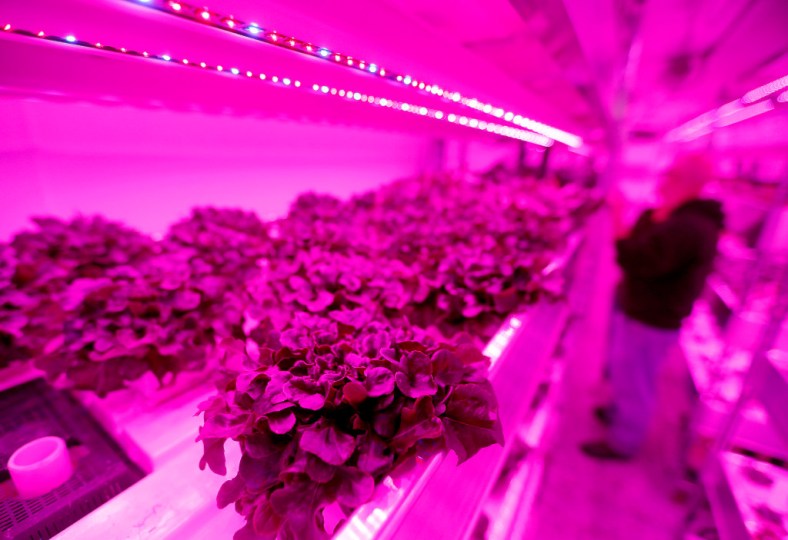Published by the Dallas Morning News
You want fresh? Dallas’ Central Market is growing salad behind the store
Fresh is a word that’s used loosely in the grocery business.
To the consumer, everything in the produce section is fresh. But most fruits and vegetables are picked five to 21 days earlier to make it to your neighborhood grocery store.
Central Market wants to redefine fresh when it comes to salad greens and herbs. It also wants to make available to local chefs and foodies specialty items not grown in Texas like watermelon radishes or wasabi arugula.
And it wants to be both the retailer and the farmer with its own store-grown produce.
The Dallas-based specialty food division of H-E-B has cooked up an idea to turn fresh on its head with leafy greens and butter lettuce still attached to the roots and technically still alive.
Beginning in May, the store at Lovers Lane and Greenville Avenue in Dallas will have a crop of about half a dozen varieties of salad greens ready for customers to purchase.
The greens will be harvested just a few dozen steps from the store’s produce shelves.
They’re being grown out back, behind the store in a vertical farm inside a retrofitted 53-foot long shipping container. Inside, four levels of crops are growing under magenta and other color lights. In this controlled environment, there’s no need for pesticides and no worries of a traditional farm or greenhouse that it’s been too cloudy outside.
Central Market has been working on the idea for about a year with two local partners — Bedford-based Hort Americas and Dallas-based CEA Advisors LLC — in the blossoming vertical and container farming business.

“We’re the first grocery store to own and operate our own container farm onsite,” said Chris Bostad, director of procurement, merchandising and marketing for Central Market.
There’s a Whole Foods Market store in Brooklyn, New York with a greenhouse built on the roof, but it’s operated by a supplier, urban farmer Gotham Greens.
The difference, Bostad said, is that “we can grow whatever our customers want versus someone who is trying to figure out how to cut corners and make a profit.”
Central Market’s new venture is starting out with the one Dallas store, said Marty Mika, Central Market’s business development manager for produce. “But we’ll see what the customer wants. We can do more.”
This has been Mika’s project. He’s itching to bring in seeds from France and other far off places, but for now, he said,“We’re starting simple.” The initial crop included red and green leafy lettuce, a butter lettuce, spring mix, regular basil, Thai basil and wasabi arugula.
The cost will be similar to other produce in the store, Bostad said.
Why go to so much trouble? Why bother with lighting and water systems and temperature controls in what’s become a high-tech farming industry?
“Taste,” Mika said. “Fresh tastes better.”
And the company wants to be more responsive to chefs who want to reproduce recipes but don’t have ingredients like basil leaves grown in Italy that are wide enough to use as wraps.
Tyler Baras, special project manager for Hort Americas, said with the control that comes with indoor farming there are a lot of ways to change the lighting, for example, and end up with different tastes and shades of red or green leafy lettuce.

In Japan, controlled environment container farms are reducing the potassium levels, which is believed to be better for diabetics, Baras said. “We can increase the vitamin content by controlling the light color.”
At Central Market, the produce will be sold as a live plant with roots still in what the industry calls “soilless media.”
Central Market’s crops are growing in a variety called stone wool, which is rocks that are melted and blown into fibers, said Chris Higgins, co-owner of Hort Americas. The company is teaching store staff how to tend to the vertical farm and supplying it with fertilizer and other equipment.
“Because the rocks have gone through a heating process, it’s an inert foundation for the roots. There’s nothing good or bad in there,” Higgins said.
Farmers spend a lot of time and money making sure their soil is ready, he said. “The agricultural community chases the sun and is at the mercy of Mother Nature. We figure out the perfect time in California for a crop and duplicate it.”

He called it a highly secure food source and in many ways a level beyond organic since there are no pesticides and nutrients are water delivered.
Glenn Behrman, owner of CEA Advisors, supplied the container and has worked on the controlled environment for several years with researchers at Texas A&M.
“Technology has advanced so that a retailer can safely grow food. Three to five years ago, we couldn’t have built this thing,” Behrman said.
Mika and Bostad said they also likes the sustainability features of not having trucks transport the produce and very little water used in vertical farming. They believe the demand is there as tastes have changed and become more sophisticated over the years.
The government didn’t even keep leafy and romaine lettuce stats until 1985.
U.S. per capita use of iceberg, that hardy, easy to transport head of lettuce, peaked in 1989. Around the same time, Fresh Express says it created the first ready-to-eat packaged garden salad in a bag and leafy and romaine lettuce popularity grew.
In 2015, the U.S. per capita consumption of lettuce was 24.6 pounds, 13.5 pounds of leafy and romaine and 11 pounds of iceberg.
Twitter: @MariaHalkias



